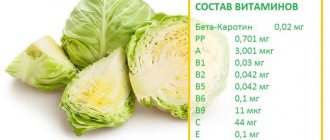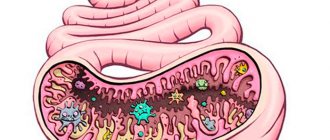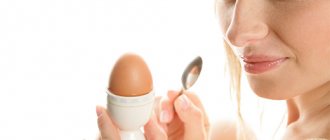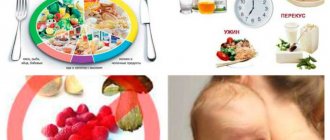Composition of cabbage
The chemical composition is described in detail in the reference book of Russian scientists Skurikhin I.M. and Tutelyan V.A. “Tables of the chemical composition and calorie content of Russian food products.”
Vitamins:
- A – 2 mcg;
- E – 0.1 mg;
- C – 45 mg;
- B1 – 0.03 mg;
- B2 – 0.04 mg;
- B6 – 0.1 mg;
- B9 – 22 mcg.
Energy value 100 g. fresh leaves - 28 kcal. Cabbage is rich in carbohydrates - 18.8 g. per 100 g, and proteins – 7.2 g.
Microelements:
- potassium – 300 mg;
- calcium – 48 mg;
- sulfur – 37 mg;
- phosphorus – 31 mg;
- chlorine – 37 mg;
- boron – 200 mcg;
- molybdenum – 10 mcg.
The composition also contains “magic” tartronic acid and a rare substance methionine - or vitamin U. Tartronic acid can stop the conversion of carbohydrates into fats. Vitamin U heals erosions, wounds and ulcers on the mucous membranes.
Benefits of cabbage
In 1942, a scientist from the USA, Chiney, discovered a substance in cabbage juice that heals erosions of the mucous membranes of the stomach - methylmethionine sulfonium, later called vitamin U. In 1952, Mac Rory proved the ability of methylmethionine sulfonium to heal wounds and ulcers. Because of its fiber, cabbage is not allowed during periods of exacerbation of ulcers, but the juice is used to treat stomach ulcers, psoriasis and eczema.
Fights cholesterol deposits
Cholesterol plaques are protein-bound lipoproteins deposited on the walls of blood vessels. Vitamin U is involved in metabolic processes, including fat. Entering the blood, the substance prevents cholesterol from sticking to proteins and settling on the walls of blood vessels.
White cabbage is useful for the prevention of atherosclerosis and high cholesterol.
Prevents fat formation
The vegetable contains tartronic acid, which is an organic acid. Like tartaric, citric, malic and oxalic acids, tartronic acid alkalizes the environment in the stomach, prevents fermentation and improves digestion. But the uniqueness of tartronic acid is that it prevents the appearance of fat deposits - this explains the benefits of the vegetable for weight loss. Tartronic acid does not break down existing fats, but it does not allow new ones to form. This property is explained by the fact that tartronic acid stops the process of converting carbohydrates into triglycerides.
Fresh cabbage and sauerkraut are useful, since tartronic acid is destroyed during heat treatment.
Cleanses the intestines
100 grams of vegetables contain 10% of the daily intake of dietary fiber, which stimulates intestinal motility. Without fiber, the intestines become lazy, and the smooth muscles of the organ atrophy. The benefit of raw cabbage is that fiber irritates the intestinal walls, prevents them from “falling asleep” and triggers self-cleansing. During work, the intestines are cleansed of toxins. The vegetable is useful for long-term constipation and intestinal motility disorders.
For men
The benefit of the vegetable is to reduce the risk of developing prostate cancer. Cabbage contains vitamin B9, which is necessary for the production of high-quality sperm.
For pregnant
The benefits can be judged based on the vitamin and mineral composition. Cabbage is rich in potassium, vitamin C, folic acid, and fiber.
- Potassium helps avoid swelling, which is important for pregnant women.
- Vitamin C thins the blood. Viscous blood is a problem for expectant mothers, which can cause fetal death.
- Folic acid is necessary for the fetus. If the fetus did not receive enough folic acid in the womb, the child may be born with abnormalities.
Sauerkraut eliminates nausea. The vegetable will be beneficial for toxicosis: it will relieve aversion to foods and at the same time provide the body with deficient vitamins.
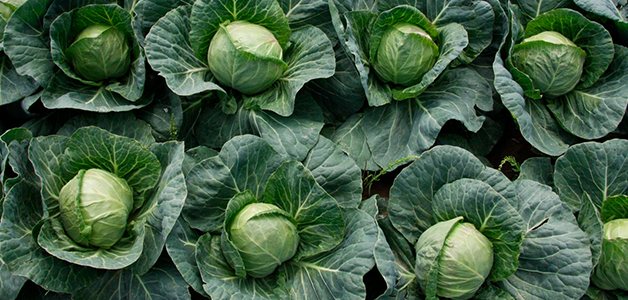
For children
Boosts immunity
Vitamin C molecules are mobile and fast, easily penetrate into the blood and organs, and are quickly absorbed by the body. Animals do not suffer from a lack of ascorbic acid, since they are able to produce it themselves, and people get the vitamin from food. That's why people get colds and flu more often than animals.
Green vegetables in the diet for diarrhea: allowed and prohibited
Nutrition during diarrhea is based on foods that prevent the appearance of unpleasant symptoms and minimize them.
Thus, green vegetables for diarrhea belong to a controversial group, some of which can be consumed, while others are strictly prohibited. For the most part, everything green has a sour taste or contains a large amount of fiber. And acid and fiber negatively affect the digestive process during diarrhea.
Effect of vegetables on the body
Diarrhea occurs as a result of several reasons. One of the most common is the sudden development of pathogenic microorganisms in the stomach and intestines.
The second reason is the accelerated process of removing food from the intestinal tract, often undigested. Another reason is increased mucus production.
And the list ends with the reason why the absorption of liquid is disrupted; the body does not absorb it, but secretes it and removes it from the body.
Acidic green, yellow and red vegetables, including pickled foods, promote the development of pathogenic microorganisms. With diarrhea, this turns out to be a critical factor, since the balance of the flora is disturbed.
Spicy green vegetables and spices such as capsicum and garlic are very irritating to the intestines. Due to this, mucus secretion and motility increase, and the recovery process also worsens.
Another class of plant foods that have a dual effect on the body are mushrooms. This also includes vegetables with similar effects - beets and corn. They can enhance peristalsis, but they are great for diarrhea caused by excessive mucus production.
Prohibited green vegetables for diarrhea
Some classes of green vegetables are completely prohibited for consumption during diarrhea:
- Salted cucumbers. Fresh cucumbers improve peristalsis, normalize bowel movements and can be consumed in small quantities for diarrhea if it is accompanied by dehydration. The water contained in vegetables helps restore balance. Moreover, cucumbers contain iodine, phosphorus, vitamins and calcium. However, salted vegetables lead to acute diarrhea.
- Cabbage. White cabbage stimulates peristalsis and contains a lot of fiber; it is contraindicated for diarrhea. May cause fermentation and flatulence. Sauerkraut is useful in the absence of intestinal problems, but during diarrhea it can significantly worsen the patient’s condition.
- Green hot pepper. Spicy foods should not be included in the diet for diarrhea, and chili peppers are no exception. It irritates the walls of the stomach and intestines, causing bloating.
- Broccoli and cauliflower. In most cases, they increase diarrhea, as they contain a high concentration of fiber. Green salad and asparagus are also prohibited from the cruciferous family.
All varieties of green vegetables with a pungent taste, such as radishes, are excluded from the diet. They can irritate the stomach, like onions and hot peppers.
The occurrence of diarrhea from vegetables
It happens that diarrhea goes away, but literally after 1-2 weeks it returns again. Many begin to suspect the presence of some kind of disease due to relapse of the pathology. But the cause may be green vegetables, diarrhea from which develops as a result of pathogenic bacteria and product abuse.
Topping the list is the development of harmful microorganisms in pickles - a jar of cucumbers often causes diarrhea. A similar condition appears after eating fermented sauerkraut.
Important! If a person has a sensitive intestine that reacts to simple foods, then raw garlic is contraindicated for him.
Diarrhea can also appear from low-quality cucumbers purchased in the store in December-March. At this time, they contain a minimum of nutrients and a maximum of nitrates.
Recommendations for products for diarrhea
The main foods during diarrhea are vegetables, cereals and low-fat protein foods that can stop diarrhea. They have a good effect on the body, saturate and cleanse it of harmful substances. Vegetables are considered the most controversial issue. Here are some of them you can eat while treating diarrhea:
- zucchini – have a strengthening effect and are safe for diarrhea;
- eggplant is a tasty product that, when boiled or baked, helps fight pathology;
- boiled carrots and beets;
- green peas and green beans in limited quantities.
If you have severe diarrhea, the last two products should be avoided, as they belong to the legume family and often cause bloating and flatulence. You can also eat other vegetables stewed and boiled, but in limited quantities:
- green and red bell peppers;
- mashed potatoes;
- broccoli, subject to normal tolerance (may cause diarrhea in some);
- fresh cucumbers, but only from the garden, not store-bought;
- corn – in small quantities treats mucous diarrhea;
- pumpkin – has a strengthening effect;
- Fresh tomatoes are nutritious vegetables, which are recommended 3-4 days after passing the acute stage of diarrhea.
Fruits and berries have an even more acute effect on the irritable intestines and stomach, so the choice is significantly limited: you can eat pureed apples and bananas, as well as baked quince. The berries allowed are blueberries, chokeberries and dried bird cherry. You can make jelly and jellies from these products.
You can eat greens when you have diarrhea, but garlic and green onions - only in processed form and in limited portions. In general, all vegetables and fruits during diarrhea should be consumed boiled, stewed or baked. The only exception is fresh cucumbers.
Not all green vegetables can be dangerous if you have diarrhea. But you should be especially wary of fresh and salted vegetables during periods of acute diarrhea.
Source: https://diarey.net/pitanie/zelenyie-ovoshhi-pri-diaree.html
Medicinal properties of cabbage
The benefit of cabbage for the body in the winter and spring is to strengthen the immune system. The amount of vitamin C increases with fermentation. 200 grams will help provide the body with a sufficient dose of vitamin C. raw or 100 gr. sauerkraut per day.
For erosive gastritis, stomach and intestinal ulcers
The discovery of vitamin U, which heals wounds, marked a new stage in the treatment of peptic ulcers. Cabbage juice began to be used to heal wounds and stomach erosions. For treatment, juice from the leaves is used.
- Pass several peeled top sheets through a meat grinder.
- Squeeze out the juice through cheesecloth.
Why does cabbage relieve constipation?
One of the best foods to help improve daily bowel movements is cabbage. Yes, yes, the most ordinary white cabbage. Thanks to her, the intestines work like a clock. Eat cabbage every day and you will forget about bowel problems.
Cabbage is an extremely healthy vegetable. Its healing properties have been known for a long time. It contains a large amount of vitamins. It is especially rich in vitamin C. In this indicator, it is superior to many other vegetables.
Cabbage improves metabolism and removes cholesterol from the body. Thus, it cleanses blood vessels, improves heart function and prevents stroke. It is believed that cabbage also improves vision, cures stomach ulcers, etc.
But now we are interested in how it acts on the intestines, so we’ll talk about that. Cabbage contains a large amount of fiber. These are indigestible dietary fibers. Their role is to mechanically irritate the intestinal walls, promote its contraction and, thereby, promote food gruel to exit. Fiber is found in cabbage in large quantities. It stimulates the digestive tract, increases the secretion of gastric juice, so cabbage is extremely useful for constipation.
Useful properties of cabbage:
White cabbage contains a large amount of vitamins and minerals. Vitamin C in the leaves of early varieties contains 20 mg%, in late-ripening varieties – 70 mg%. Cabbage has the ability to retain vitamin C for a long time. The secret of this “longevity” is that vitamin C is found in cabbage not only in its pure form, but also in a chemically bound form – “ascorbigene”. Ascorbigen is the most stable form of vitamin C, and cabbage contains 50 times more of it in this form than, for example, potatoes. In general, there is only 1.5-2 times more vitamin C in cabbage than in potatoes. There is more vitamin C in cabbage than in tangerines and lemons, and 10 times more than in carrots.
Recipes with cabbage for a laxative effect
The advantage of this product is the variety of dishes that can be prepared from it. Taste qualities are practically not lost during heat treatment. It is recommended to steam, boil or stew it.
The best option is salads with the addition of fresh white cabbage. Don't forget about contraindications.
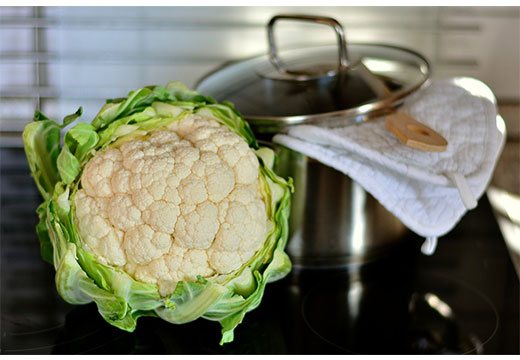
Stewed cabbage for constipation is an excellent option for consuming this vegetable; it does not require much time or special skills to prepare. You need to cut it into small strips, put it in a deep bowl or frying pan, add half a glass of water, cover with a lid. Simmer for 30 minutes over medium heat, stirring occasionally.
Fresh cabbage can be eaten in its pure form, but you can prepare salads.
- With cucumber. You will need to take 0.5 kg of cabbage, two fresh cucumbers, dill, salt, and vegetable oil. Finely chop the cabbage leaves, add salt, mix well and crush until the juice appears. Then chop two cucumbers and dill. Mix all. Add vegetable oil in the required volume. To stir thoroughly.
- Salad with carrots. You should take one medium-sized head of cabbage, three carrots, one glass of kefir or low-fat yogurt (unflavored). Finely chop the head of cabbage into strips, wash the carrots, grate or chop them. Mix the ingredients. Add kefir or yogurt and mix well. If such a dressing is not available, you can use sunflower oil.
If you decide to use these methods to treat constipation, increase your daily water intake.
Sauerkraut is healthy, especially in winter, due to its high content of vitamins. High concentration of vitamin C, which affects the body's immune defense. This is used when preparing salads, borscht, soups, and with meat.
Salad with carrots. The recipe is similar to that described above for fresh vegetables, but replace fresh sauerkraut. Season with vegetable oil.
Sauerkraut in its own juice. For the recipe you need to take 3 kg of cabbage, 2 carrots, salt (2 tbsp), sugar (1 tbsp). Vegetables are cut into strips or grated on a coarse grater, then salt and sugar are added and mixed well. Then press the mixture lightly with your hands until the juice appears. Place the mixture in a pan or bucket, compact it tightly, and place a weight on top. Leave in this state for 4 days at a temperature of 19-21 degrees. The appearance of foam or bubbles indicates that you have stopped fermenting it. Make several punctures with a skewer into the thickness of the mixture and transfer to a cool place for 1-2 days. After that you can try. Eat it pure or add it to other dishes.
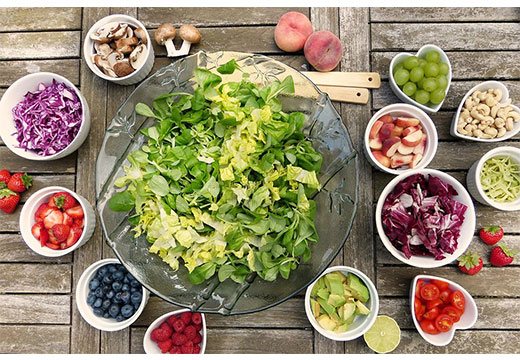
Laminaria is a great remedy for constipation. For the recipe you will need:
- 50 g canned seaweed;
- 50 g white cabbage;
- cucumber;
- sunflower or olive oil;
- green onions;
- sugar, salt.
Cabbage leaves, cucumbers, green onions are chopped and added to canned kelp, which should be cut into strips if necessary. Season with oil and add salt and sugar to taste.
In dry form, brown algae helps with chronic problems with bowel movements. Usually, 5 grams of powder are diluted in 250-300 ml of water (warm) and taken once a day before bed. More precisely, the dosages are indicated in the attached instructions for the drug. The period during which kelp powder is taken is from 10 days to 4 weeks.
Contraindications:
We have already figured out why cabbage is useful. But can it do any harm?
Compared to the beneficial properties, there is little harm; there are some contraindications. Thus, overeating the product in its raw form can lead to nausea, bloating, and heaviness in the stomach.
It is not recommended to use the product if you have high acidity, enteritis, colitis, myocardial infarction, or diarrhea.
You cannot constantly eat raw stalks, since they accumulate harmful substances that the vegetable absorbed during growth (copper salts, nitrates, cadmium).
It is not recommended to eat cabbage if you have thyroid diseases! Cabbage helps cure gastric and duodenal ulcers, but in severely advanced cases and severe exacerbations, cabbage can already cause harm. Increased acidity of gastric juice also does not like cabbage, but in this case it is not contraindicated, but should be consumed within reasonable limits and preferably not raw. Sauerkraut can also be harmful to the kidneys and liver due to its high salt content, and can also harm hypertensive patients. If you really want sauerkraut, we advise you to wash it well from the brine or initially ferment it with a minimum of salt.
When choosing cabbage, the head should be dense and the cut should be white. If the cut is dark brown, it means that it has already been stale and has lost a significant part of its beneficial properties. You should not buy vegetables with stains, deep damage or foreign odors. Fresh cabbage should not have limp leaves, it is usually bright green in color and heavy in weight.
Benefits of cabbage:
For women:
Women who care about their figure need to pay special attention to this vegetable. After all, it contains tartronic acid, which prevents the carbohydrates we consume from turning into fatty deposits. But for many, it’s so hard without sweets. By the way, tartronic acid is susceptible to heat treatment, but it remains perfectly preserved in fermented water.
Cabbage also contains folic acid, which is so necessary for us women. Cell renewal and oxygen saturation cannot occur without it. And it is indispensable for the skin and hair. Probably everyone knows about the need for folic acid during pregnancy. But it is necessary for both teenage girls (corrects puberty) and older women.
It’s unlikely that anyone is serious about the possibility of enlarging their breasts by eating cabbage, but it has been proven that this vegetable contains a substance that is effective in preventing breast cancer. This substance is sulforaphane.
For men:
As for men, earlier, if their virility weakened or potency deteriorated, ancient healers prescribed wrapping the penis in a fresh cabbage leaf and keeping it there all night.
When talking about the benefits of cabbage for men, we can’t help but talk about sauerkraut. This is a popular, favorite snack, without which Russian feasts are not complete, strengthens the immune system, and increases resistance to stress. It activates metabolic processes. Moreover, it improves blood quality, reduces cholesterol and has a rejuvenating effect on the body, strengthens the heart.
Men who regularly consume sauerkraut remain energetic for many years and do not lose interest in life until old age and retain their virility. Well, its brine is a unique source of vitamin C. Brine is very useful for digestion, eliminates constipation, and relieves hemorrhoids.
For children:
The list of first complementary foods for babies, of course, consists of vegetables, but white cabbage for children under the age of one and a half years is not included in this list. The reason is trivial - a popular vegetable in our country can cause bloating, and the digestive system of babies is especially sensitive to excessive gas formation.
However, your child’s future diet will certainly contain white cabbage. In kindergartens, in the school canteen or in the home kitchen, this vegetable has no substitute, because not many products are available fresh all year round and without loss of taste and beneficial qualities. It is rich in phosphorus and potassium salts, contains a number of vitamins and minerals necessary for both children and adults. Nutritionists have not ignored it either: white cabbage is not dangerous for children with food allergies, and therefore fully complies with dietary requirements.
Kids, as a rule, respond well to cabbage dishes. It does not burden the digestive system, cooks quickly, and has a pleasant taste.
Healthy snacks and salads for stomach diseases
Recipes for salads and snacks for gastritis are as numerous as recipes for harmless soups. We will talk about ways to prepare several of the simplest cold dishes.
Cold dishes are rightfully considered table decoration. The main component of salads is vegetables or fruits - an irreplaceable source of vitamins.
Vitamins for chronic gastritis (CG) are necessary, as they help a weakened body resist the development of the pathological process.
What salads can you eat if you have gastritis?
Classic holiday salads, as a rule, are strictly prohibited for people diagnosed with hCG. Patients should not eat the eternal New Year's delicacies - mimosa from canned fish, herring under a fur coat, vinaigrette. Such dishes contain ingredients that are unacceptable for a vulnerable stomach.
Crab salad is again not advisable. Firstly, gastritis sufferers should not consume mayonnaise, secondly, crab sticks are not recommended for them, and thirdly, rice is contraindicated if they are prone to constipation.
To avoid mistakes, remember the following list of prohibited salad ingredients:
- kvass;
- vinegar;
- mayonnaise;
- pickled vegetables;
- mushrooms;
- onion and garlic;
- radish;
- peppers;
- horseradish;
- smoked meats;
- canned food;
- hot ready-made seasonings;
- rice, peas and other legumes - for bowel problems.
What does cabbage cure?
How to treat gastritis with cabbage?
One of the most proven methods is to treat gastritis with cabbage juice. Most people underestimate this vegetable, but in vain. After all, white cabbage is a real chest of vitamins. In particular, it contains a unique vitamin U (methylmethionine), especially necessary for a person with gastritis or ulcers, as well as PP, which tidies up the functioning of the gastrointestinal tract.
We can say that cabbage juice is considered somewhat exotic, and sauerkraut is a completely familiar dish, which, however, should not be consumed during the phase of exacerbation of the disease. And in the subsiding phase of the disease, sauerkraut for gastritis contributes to:
- improving motor skills;
- eliminating constipation;
- improving microflora in the intestines;
- increasing immunity;
- eliminating inflammation in the mucous membrane.
And sauerkraut for gastritis with high acidity can be consumed limitedly, but only during the period of subsidence of the disease. It is best to abandon it in this form when the acid level increases, so as not to cause complications of gastritis and stomach ulcers.
The main product in the treatment of this disease (especially when the acidity level decreases) can be stewed cabbage. During stewing of vegetables, useful elements are preserved, which help improve the functioning of the digestive tract and reduce the load on the stomach tissue. Stewed cabbage for gastritis has the following effects:
- eliminates inflammation of the mucous membrane;
- accelerates regenerative processes;
- improves digestion;
- perfectly satisfies hunger while following a strict diet;
- reduces pain.
How to eat cabbage with pancreatitis?
White cabbage in the acute phase of pancreatitis:
The inflamed pancreas quickly and violently reacts to any dietary deviations with painful attacks, increased vomiting, profuse diarrhea, renewed fever, bloating and some other serious symptoms. Dishes with white cabbage can provoke or intensify all these unpleasant signs of an acute process in the pancreas. This negative impact is due to the content in it:
- Essential oils (it is their presence that explains the pungent taste of raw cabbage);
- Coarse fiber (fibers are visible even to the naked eye in cabbage), the amount of which is 2 g per 100 g of product.
What can and cannot be eaten if you have diarrhea?
Diarrhea / Treatment of diarrhea / What can and cannot be eaten if you have diarrhea?
The diet for diarrhea depends on the duration of the disease. Of course, we are not talking about particularly dangerous infections such as cholera or typhoid fever, in which there is a real threat to the patient’s life.
Let's look at cases of acute and chronic diarrhea, which is relatively benign.
It can be caused by bacterial and fungal infections, food and drug poisoning, irritable bowel syndrome, dysbacteriosis, and psychosomatic increased intestinal motility.
On the very first day of illness, drinking plenty of fluids is a vital necessity. This will neutralize the effects of dehydration that is inevitable with diarrhea.
There are special balanced salt preparations that restore electrolyte balance, in particular the content of sodium, magnesium, and calcium ions in the body’s fluids, which are washed out of the intestines first.
The best option for replenishing important microelements is coral water, since all its components are present in organic form - the best for absorption by our body. But not everyone has the opportunity to buy such bags of coral powder to structure water.
Principles of diet for diarrhea
Doctors determine what you can eat for diarrhea based on the following simple rules by eliminating everything that is harmful to the painful gastrointestinal tract:
- fragmentation of nutrition - to minimize the immediate load on an unhealthy intestine, food should enter it in small portions after 2 - 3 hours;
- exclude all yeast products;
- exclusion of chemical and mechanical irritants. Food should not be very hot or cold, contain hard-to-digest solid particles, acid, or spices;
- inadmissibility of consuming choleretic products, including coffee;
- prohibition of carbonated drinks and foods high in sugar, leading to increased fermentation.
The energy value of food during diarrhea should be at the maximum level, and the quantitative value at the minimum of the natural biological needs of the body. Overeating is unacceptable.
With frequent bowel movements, the body is deprived of many useful substances, for example, important microelements, and the production of enzymes necessary for digesting foods stops.
As soon as it becomes easier and the diarrhea has stopped, many pounce on tasty things, and if it is a child, then “caring” mothers and grandmothers strive to make up for everything that the poor child was not able to eat during the illness.
And the body has not yet had time to recover, in particular, to produce the required amount of digestive enzymes. As a result, the intestines again become clogged with undigested food, the intoxication process resumes, and everything goes in a circle.
Some doctors prescribe enzymes in the form of drugs for this case, but in this case there is another, negative side of the coin that you should be aware of.
The more enzymes supplied from outside, the less the body will produce them. But our task is to restore all functions of the body.
Therefore, you need to stick to the diet, even if you feel better and there are no obvious signs of illness.
Prohibited Products
Let’s now look at what you can’t eat if you have diarrhea, either in the acute stage or in the recovery stage. The list is wide, but for a person who is tormented by diarrhea, life appears in much less rosy colors and it will not be so difficult for him to cope with temptation.
You should avoid the following products:
- Any meat, especially fatty meat, fried in a golden brown crust, smoked.
- Offal – brains, liver, kidneys.
- Sausage, frankfurters, smoked meats.
- Any fish - fatty, fried, smoked, salted, canned.
- Whole milk and dairy products - sour cream, cream, yoghurts, cheeses, cottage cheese, carbonated whey.
- Hard-boiled and fried eggs.
- Fresh and sauerkraut, radishes, cucumbers.
- Factory-made and home-made canned vegetables.
- Horseradish, mustard, ginger, other spices.
- Mushrooms in any form.
- Any very sour fruits and berries.
- Baked goods, yeast bread, pies, pastries, cakes, sweets.
- Cold and carbonated drinks.
- Alcohol.
What can you eat if you have diarrhea?
The list of acceptable and medicinal products for diarrhea includes:
- yeast-free white crackers;
- starch solution (natural enterosorbent);
- thick rice soup cooked in water;
- flax or hemp porridge in water;
- gooseberry berry pulp with the addition of banana and honey;
- bird chokeberry compote or infusion (or chokeberry);
- pear compote;
- rowan juice or infusion;
- blueberry or blackcurrant jelly;
- infusion of chicory, hawthorn;
- tea from raspberries, blackberry leaves, sage or linden flowers, chamomile, St. John's wort;
- infusion of alder cones;
- pomegranate infusion;
- strong black loose leaf tea without sugar.
You can eat 4-6 black peppercorns on the first day. If the diarrhea does not go away, the dose can be repeated.
https://www.youtube.com/watch?v=cMiWu3cjFQw
On the first day you can eat 12 large grated apples, peeled. Every 2 hours take 1 apple. Do not eat or drink anything else. Usually this method can completely stop the diarrhea.
Diarrhea accompanied by vomiting can be stopped by adding lemon juice to warm water.
Now let's see what you can eat during the recovery period, when the acute stage has passed.
First, you need to minimize the amount of food you consume. Secondly, you should switch to a vegetarian menu. The list of permitted products includes:
- Porridge cooked in water from any grain except pearl barley.
- You can make light soups from vegetables, with the exception of cabbage soup, and make puree. It is preferable to steam vegetables or bake them in the oven.
- Bananas are allowed to be eaten as fresh fruit in the first days. Pears are acceptable in small quantities. Apples can be baked in the oven and eaten flavored with a small amount of honey (1-2 teaspoons). Preferable fresh or frozen berries are blueberries, strawberries, raspberries (no more than half a glass).
- In addition to crackers, it is permissible to eat dried bagels.
What can you drink if you have diarrhea?
On the first day - only clean filtered water and herbal tea. On the second day, you can drink compotes, sugar-free jelly, non-acidic freshly squeezed vegetable and fruit juices, which do not have an irritating or choleretic effect.
As the intestinal microflora and epithelium are restored, restrictions can be gradually removed.
We wish you a speedy recovery and normalization of the gastrointestinal tract!
Source: https://xn—-7sblfbaasf1ay4a9g2e.xn--p1ai/lechenie-diarei/chto-mozhno-i-chego-nelzya-est-pri-diaree.html
How to treat bruises, swelling and bruises with cabbage?
The properties of cabbage leaves to heal wounds and stop bleeding are used for bruises, especially on the arms and legs. Swelling and pain decrease, hematomas resolve, and the consequences of bruises are not so serious.
You can apply a clean whole cabbage leaf to the bruised area, or you can squeeze the juice out of it, moisten a piece of cotton or linen cloth with it and apply it to the damaged area, applying any securing bandage. This lotion quickly relieves pain and restores damaged tissue.
How to apply cabbage leaves to sore spots?
First of all, I would like to say that it is best to take cabbage leaves for medicinal purposes from a head of cabbage grown on your own plot or purchased at the market from farmers and individuals. Leaves for compresses must be thoroughly rinsed with running water and dried.
If the leaves are applied to wounds or other damaged skin surfaces, they should be doused with boiling water before use. You can prepare several leaves in this way, put them in a plastic bag, place them in the refrigerator and use them as needed.
Before use, the leaves need to be kept at room temperature for some time, do not apply them when cooled.
Before use, the leaves must be rinsed, after removing the hardest parts of the veins. This is done so that the leaf releases juice, thereby ensuring that all the medicinal properties of the cabbage leaf are released. You need to knead its outer side, which is applied to the sore spot, for which you can use a wooden hammer, a rolling pin for rolling out dough, or the blunt side of a knife. You can even cut the leaves slightly, but not all the way through, so that the juice does not leak out, but only moisturizes the leaves.
The thickness of the compress depends on the size of the painful area and the size and thickness of the leaves themselves. Sometimes one or two leaves are enough, and sometimes you may need a stack of leaves that overlap each other with a slight overlap.
Cabbage leaves should fit tightly to the sore spot and be secured with a bandage.
Cabbage, included in the traditional borscht set, is grown in many countries and is one of the most popular vegetables. Having begun its spread throughout Europe from the Mediterranean countries, it has firmly established itself in Siberia and the Non-Black Earth zone of Russia. Some consider Russia to be the birthplace of cabbage, because it occupies a significant share of the volume of vegetables grown and has many selected varieties bred by Russian scientists. It is very important to know about the benefits and harms of cabbage in order to use it correctly - this is discussed in detail in the article.
Composition of white cabbage
To better understand the benefits and harms, you need to familiarize yourself with the composition of the vegetable. Cabbage consists mainly of water and has a low calorie content of 27 kcal (per 100 g). Cabbage is rich in vitamins B, C, macro- and microelements. Cabbage contains the most potassium and calcium, magnesium, phosphorus, iron, fluorine, and manganese.
Here is a detailed list of the composition of white cabbage:
- glucose and fructose (sugars);
- carbohydrates;
- fats;
- potassium salts;
- phosphorus salts;
- copper;
- iodine;
- calcium;
- magnesium;
- iron;
- manganese;
- cellulose;
- phytoncides (natural antibiotics);
- lipase;
- protease;
- enzymes;
- lactose;
- vitamins A, B1, B6, P, K, U (anti-ulcer vitamin);
- 16 free amino acids, including some of the most important for the body: lysine, histidine, methionine, tyrosine.
This entire impressive list is contained in large quantities mainly in freshly squeezed cabbage juice, which can be obtained at home without difficulty and much effort by chopping fresh leaves of the vegetable and squeezing them through cheesecloth.
As you can see, cabbage is a storehouse of nutrients. And its beneficial effects on the body are multifaceted.
Diarrhea from cauliflower
Your stomach is twisting, but you can’t imagine that you could have eaten something of poor quality? Diarrhea is not always caused by spoiled foods or intestinal flu.
This list will be especially useful for people who are prone to similar eating disorders, writes Clutch.
Nutrition experts have named seven foods that can trigger diarrhea.
Hot spices
Palchevsky made a remark to Zelensky: “with all the love for a particular oligarch, it’s necessary...”
The reason lies in the fact that when the stomach digests food, hot spices in it can cause irritation, which causes gas, bloating, and, often, diarrhea. Therefore, if you are a fan of chili peppers and curry sauce, remember that you need to be very careful when eating such products.
Sugar substitutes
Artificial sweeteners such as aspartame, saccharin and sugar alcohol disrupt the biology of the lower gastrointestinal tract. That is why people suffering from irritable bowel syndrome are advised to avoid sweeteners.
Milk
If you regularly consume milk and dairy products, and often visit the toilet, you may need to think about a disorder called lactose intolerance. In this case, it is better to use an alternative to cow's milk - soy, almond or coconut milk.
Coffee with milk
Garlic and onion
Both of these foods contain high amounts of insoluble fiber and juices, which when broken down by stomach juices cause gas. These gases subsequently irritate the stomach itself, which provokes further problems with the toilet.
Broccoli and cauliflower
The case when excessive benefit is bad. Both products contain a large amount of nutrients and dietary fiber: if the body is not accustomed to them, it will simply be difficult for it to cope with these fibers, which will ultimately cause diarrhea.
Fast food
Due to the fact that it contains saturated fats, it is difficult for the body to cope with them. Fast food can linger in the body, causing stomach disorders.
Diarrhea is characterized by loose stools and a feeling of discomfort. Diarrhea from cabbage can cause chronic colitis. Vegetables contain coarse fiber, and an inflamed colon is unable to cope with it.
Causes of diarrhea after eating cabbage
The common cabbage and cauliflower are saturated with substances that provide antioxidant (neutralization of the oxidative effect of free radicals, etc.)
substances), anti-inflammatory, anti-cancer and laxative effect.
The head (core) of cabbage contains sugar, fat, fiber, various vitamins and phytoncides (biologically active substances that kill or suppress the growth and development of bacteria, microscopic fungi, protozoa).
The vegetable has found its place in folk medicine in the form of juice in its original fresh form.
Cabbage is usually prescribed to people suffering from frequent constipation (including chronic), lack of appetite and dyspeptic disorders (impaired normal functioning of the stomach, difficult and painful digestion).
The vegetable has a slight laxative effect, this helps improve the digestive system, increases appetite and fights off dyspeptic symptoms (pain in the upper abdomen of unknown localization, feeling of nausea, heartburn and fullness in the stomach, instant satiety after eating, etc.).
After eating cabbage, during normal functioning of the body, diarrhea, flatulence, heartburn, abdominal pain and severe diarrhea may appear. The reason for this symptomatology is the content of allyl vegetable mustard oil, which has an irritating effect on the mucous walls of the digestive organs.
Home treatment for the condition
Whenever the body’s condition worsens, a person tries to avoid qualified help (doctor) and tries in every possible way to solve the problem on his own. This decision is not always considered correct, but treating diarrhea at home is possible. You can eliminate the problem as soon as possible using the following folk remedies:
Strong tea is considered a fairly simple and inexpensive remedy for diarrhea. Black and green can be brewed.
The drink contains catechins that can destroy harmful bacteria. Pathogenic microbes that cause diarrhea die on the third or fourth day.
Source: https://v-nashem-mire.ru/info/ponos-ot-cvetnoj-kapusty/
Benefits of cabbage
- Cabbage juice helps with urinary problems. And the presence of fiber removes cholesterol and other toxins from the body.
- Cabbage is useful for cardiovascular diseases: eating cabbage cleanses the walls of blood vessels and resists the development of atherosclerosis.
- Cabbage is rich in vitamin U, which is rarely found in its natural form, which can protect the gastrointestinal tract (gastrointestinal tract) and heal ulcers. But you can eat it only during the period of remission and first in boiled form.
- It also eases the course of liver diseases.
- Cabbage is very useful for people who are overweight. The presence of tartronic acid in its composition inhibits the process of converting glucose into fat.
- Many men are familiar with the relieving effect of cabbage brine to relieve hangovers. And if you eat sauerkraut before the feast, you can avoid intoxication.
- Fresh cabbage leaves are applied as a compress for bruises and inflammation of the joints. And if you smear a cabbage leaf with honey and apply it overnight, its healing effect will increase.
- Cabbage is beneficial for diabetics as it lowers blood glucose levels. Cabbage juice is taken as an expectorant for coughs and bronchitis.
Benefits of sauerkraut
Sauerkraut rivals citrus fruits in terms of vitamin C content. Fresh cabbage contains the natural substance ascorbigen, which during fermentation is converted into vitamin C, and in significant quantities. Lack of ascorbic acid causes loss of strength. The reason for the lack of vitamin C in the body is reduced immunity, it causes weakness and contributes to frequent colds. And the easiest, cheapest and most delicious way to make up for its deficiency is to eat a little sauerkraut every day.
Benefits of cabbage juice
Sauerkraut juice does not contain fiber, so it is preferable for those who suffer from flatulence or other gastrointestinal diseases.
How to choose cabbage
The main criteria for choosing white cabbage are simple. The head of cabbage should be elastic; this can be easily checked by squeezing it. Cabbage leaves should be a natural bright green color. There should be no spots on the outer leaves - yellow, brown or otherwise. There should be no dents or damage on the head of cabbage, and the cabbage should not have any unpleasant odors. When cut, cabbage should only be white. It is considered optimal if a head of cabbage weighs at least 1 kg.
White cabbage is usually stored for 5 months. This period depends on the type of vegetable. The best temperature for storing cabbage at home is 0 °C. At +4 ˚С and above it begins to germinate.
Cabbage is familiar to all of us, it is unpretentious, grows everywhere and constantly pleases with its freshness and its special taste. We can always use the beneficial and medicinal properties of white cabbage for our health, because this vegetable is both pleasant and affordable.
And today Chris Botti with the composition Lisa . I introduced you to an amazing trumpet player. No matter how much I listen to him, it’s always just pleasure...
At any time it was difficult to find a vegetable more widespread and healthy than cabbage. This garden doctor cures many diseases. Helps with any disorders of the gastrointestinal tract, and its healing and absorbable properties are simply priceless. Cabbage contains many vitamins, ranging from vitamin C, which can be found quite easily, to the complex and rare vitamin U, which is found in a rare number of vegetables. In this article you will learn how cabbage works and how it affects the intestines.
Our body is susceptible to stress and, as a result, disruptions that are accompanied by loss of sleep, appetite, diarrhea or constipation. This can all be a consequence of poor ecology. How to deal with this, how to protect yourself from the adverse effects of nature? We will not be able to protect ourselves completely from harmful radiation or from stress, but we can facilitate the recovery process. To help - regular white cabbage.
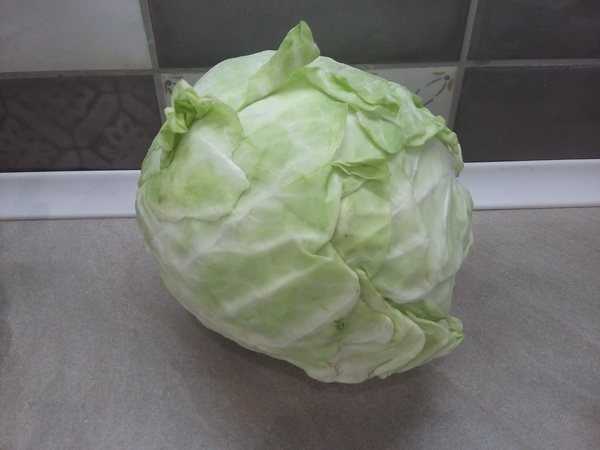
Harm and contraindications for eating cabbage
Despite its many beneficial properties, cabbage can also cause some harm to the body; it has a number of contraindications:
- Excessive consumption of cabbage may cause temporary darkening of the eyes for some.
- Men with sexual problems should limit their consumption of cabbage.
- Cabbage can be harmful for thyroid diseases - even cabbage dishes are not recommended.
- In case of exacerbation of a stomach ulcer or inflammation of the duodenum, cabbage is contraindicated.
- If you have problems with the gastrointestinal tract, replace dishes made from raw cabbage with heat-treated ones.
If there are restrictions on salt intake, it is recommended to rinse the sauerkraut. Overcooked cabbage is not beneficial. We also advise you to adhere to measures in consuming the product. And then cabbage will only bring benefits and not harm.
Eating cabbage for pancreatitis
The pancreas is a small organ that plays a large role in digestion. Malfunctions of the organ lead to a disease called pancreatitis. People suffering from pancreatitis strictly follow the main condition of therapy - diet. When limiting your food intake, it is important not to overdo it or exclude foods necessary for proper digestion. The list of vegetables allowed for consumption during pancreatitis is quite long. Does it include cabbage: white cabbage, broccoli? What are the benefits (harms) for diseases of the digestive system? To get answers to your questions, let’s look at the individual properties of the vegetable.
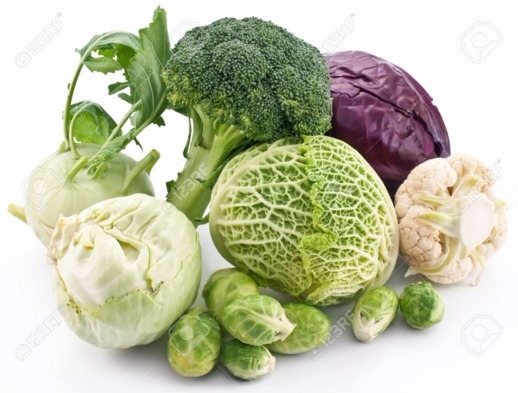
- 1 Is cabbage ok to eat?
- 2 Which cabbage is not recommended?
- 3 White cabbage
- 4 Pickled
- 5 Boiled
- 6 Cabbage juice
- 7 Healthy recipes for cooking cabbage
Is cabbage ok to eat?
There are many varieties of cabbage. Vegetables differ from each other in appearance and chemical composition. Each of them contains a different amount of vitamins, microelements and other beneficial properties. It is the content of chemical elements that prevents the addition of one type to the diet, and allows the consumption of another. A person suffering from pancreatitis must choose foods with caution, always consulting with their doctor. Unwise use of the product will cause harm, aggravating the condition of the unhealthy organ.
When creating a menu for a patient who cares about his health, it is better to include Peking, sea, broccoli, and cauliflower in the diet. Sometimes stewed cabbage is added to the diet:
- Beijing. The content of vitamins C, A, E and PP has a positive effect on the sick body. During long-term storage, the positive properties, vitamins, and microelements do not disappear, but it is better to use fresh vegetables for food. Eating vegetables raw is allowed for patients with impaired production of pancreatic enzymes. Despite the positive effects, during exacerbations of the disease you should refrain from eating cabbage.
- Brussels. The beneficial properties of the subspecies are much higher than those of a simple white cabbage sister. In terms of the content of fiber, protein, carbohydrates, phylloquinone, and B vitamins, the miniature head of cabbage is superior to an ordinary representative of the cabbage family. It has a positive effect on the mucous membrane of the organ, soothes irritation.
- Colored. The content of nutrients and vitamins prevails in comparison with other species. In terms of dietary properties and taste, it has no equal. The biochemical composition of the plant makes it healing. Cauliflower for pancreatitis does not cause irritation to the mucous membrane, and boiled and stewed cabbage is completely safe for the patient’s health. Heat treatment is not an enemy to vitamins; even after cooking, the vegetable retains its beneficial substances.
- Broccoli. Another name is asparagus cabbage. It is a close relative of the colored one. Rich in microelements and vitamins. When storing a plant for several days, the content of nutrients is halved. To avoid loss of vitamins, the plant must be stored in the refrigerator, preferably frozen. Boiled or stewed vegetables have a beneficial effect on the inflamed mucous membrane.
- Marine. A significant number of patients with pancreatitis cannot understand the beneficial properties of algae and exclude them from their diet. Completely in vain. The healing properties of kelp are known in different countries and it is necessary to eat it. The high content of iodine, potassium, magnesium, bromine makes it an indispensable product in the treatment and prevention of many diseases. Nutritionists say that kelp is the healthiest cabbage.
Eating food replenishes the daily requirement of all necessary microelements, maintains the content of nickel and cobalt, which have a positive effect on the chronic inflammatory process.
Return to contents
Which cabbage is not recommended?
The distinctive chemical characteristics of different plant species have different effects on the pancreas. In case of a chronic disease, it is worth remembering that colored broccoli is healthy, but white and sour broccoli is not only harmful to the inflamed organ, but has a destructive effect on the mucous membrane. They cannot be included in the patient menu.
Return to contents
White cabbage
With pancreatitis, strict adherence to the diet becomes inevitable.
The use of this type during exacerbation of the disease is doubtful and even harmful. The main reasons for banning this product:
- High fiber content. The pancreatic enzyme produced by the unhealthy organ is not enough to digest the vegetable. This leads to bloating and increased flatulence.
- Activation of the secretion of an unhealthy organ leads to an exacerbation of the disease.
However, during the chronic period of the disease, without obvious symptoms, it is allowed to cook cabbage. The correct approach to preparation will reduce harmful qualities. Some cooking tips:
- Cabbage for pancreatitis, as a complete, independent dish, is strictly prohibited. But if you add it to other dishes as a secondary ingredient (stew, soup, casserole), there will be no aggravations.
- A young vegetable is preferable to an old one.
- Gradual introduction to the diet, careful monitoring. At the slightest negative reaction, stop taking it.
- The amount of product taken does not exceed 100 grams per day.
Return to contents
Pickled
A healthy, tasty product, rich in vitamins and microelements, is not suitable for people with pancreatitis. Sauerkraut can easily provoke an exacerbation of the disease and contribute to the destruction of the mucous membrane. After consuming the product, nausea occurs and stool changes. Sauerkraut should not be included in the diet of people with diseases of the digestive system. Main negative factors:
- Coarse fiber. It is not allowed to be eaten even in stable remission.
- High salt content. Consumption causes swelling of the mucous membrane.
- High acidity. Causes irritation to the mucous membranes of the digestive organs.
This product should be completely excluded from the patient’s diet both during the period of stable remission and during the period of exacerbation of the disease.
Return to contents
Boiled
Boiled vegetables are endowed with positive and negative characteristics. A few tricks in preparation will help get rid of the bad properties of boiled cabbage:
- It is worth introducing dishes from boiled vegetables into the diet gradually.
- Include boiled cabbage in other dishes. As a dish on its own - under close supervision, monitoring for negative reactions.
- Eat no more than 70 grams of cooked product per day.
- The slightest aggravation is a signal to change foods in the diet.
Return to contents
Cabbage juice
It is not as popular as carrot and apple products, but it is the cabbage liquid product that is used in the treatment of many diseases. The amount of vitamins, minerals, and trace elements in cabbage juice can compete with any fruit or vegetable. You can drink the freshly squeezed product if there are no problems with the digestive system; if you have pancreatitis, it is not recommended to drink it.
Sometimes it is allowed to take syrup from a sour vegetable. The fermentation process for medicinal purposes is different. It is unacceptable to add spices and carrots to cabbage. This syrup evens out blood sugar levels and reduces pain in the pancreas.
The amount of juice consumed is strictly controlled and should not exceed a quarter glass.
Return to contents
Healthy recipes for cooking cabbage
The softest, most delicate type is cauliflower. The low fiber content makes it safe for patients with digestive problems. Despite all the positive characteristics, you should not eat it raw; it is better to heat it. The simplest and healthiest dish is puree soup. The recipe is simple:
- divide the vegetable into inflorescences;
- fill with cold water;
- boil for about twenty minutes;
- Beat the finished product with a blender; melted butter will add a pleasant, delicate flavor.
The second no less useful option is to steam the inflorescences, in the oven, or in the microwave. Not only the correctly selected product is important, but also the preparation process. List of requirements that must be observed when cooking:
- Fried foods are not allowed. The vegetable oil required for cooking overloads the unhealthy organ.
- Grated vegetables are better absorbed.
- Dishes should be warm, hot and cold negatively affect the functioning of the organ.
Pancreatitis is a disease that is always worth remembering, but it is not a reason to give up tasty and healthy food. The main condition, even if a period of weakening symptoms has begun and the disease seems to have receded, is that you must follow a diet.
A slight violation of individual nutrition leads to negative consequences.
Treatment by a doctor who wears a hundred robes: white cabbage and its valuable properties
The healing qualities of white cabbage in many areas of traditional medicine have been known for a long time and in many countries. With scientific progress and the development of medicine, the fact of the beneficial effects of this simple plant on the body has been proven and confirmed in the laboratory based on the study of its chemical composition. Upon closer examination of the substances that make up cabbage, it turned out that this simple vegetable, known to everyone since childhood, is immensely rich in many substances necessary for health and is much more useful than we used to think.
An unexpected wealth of lush green leaves
Among the variety of useful substances contained in white cabbage, it is especially worth highlighting the presence of a high level of ascorbigen - one of the forms of ascorbic acid, better known to the world as vitamin C. This form is particularly resistant to external influences, and with proper storage, chopped cabbage leaves can retain their beneficial properties due to its content throughout the whole year. It is worth noting that ascorbigen is also found in other vegetables, such as potatoes, but its amount there is almost fifty times lower than in cabbage.
Also worthy of special attention is tertronic acid, which protects the body from obesity and diabetes by preventing the processing of sugar and other carbohydrates into adipose tissue and promoting their rapid breakdown.
In addition, white cabbage contains a whole range of other substances, vitamins and microelements necessary for the body to maintain health, and even some manufacturers of pharmacy multivitamins may envy this composition.
For all ailments, cabbage is a friend
The use of this truly wonderful product is widespread in folk recipes and helps with an impressive list of diseases.
Freshly squeezed cabbage leaf juice has:
- expectorant and antitussive effect for bronchitis and sore throat;
- beneficial effect on the digestive organs of all parts of the gastrointestinal tract: accelerates gastric peristalsis and evacuation of food, improves absorption in it, reduces pain in the liver and normalizes its size, alleviates dyspeptic disorders;
- diuretic effect and promotes the passage of intestinal gases;
- pronounced antibiotic effect against Koch bacilli, Staphylococcus aureus and other dangerous pathogenic microorganisms;
- pronounced vitaminizing effect due to the high content of beneficial microminerals and vitamins;
- positive effect on low-acid gastritis, ulcerative colitis, intestinal atony, diabetes.
Cabbage juice with wine helps with bites from snakes and animals suffering from rabies, neutralizing poisons and killing bacteria.
Cabbage leaves are also used in mashed and whole form to help with burns, heat, bruises, body hyperthermia and many other diseases.
There are cabbage-based recipes that cause miscarriage when administered vaginally as lotions with juice from the leaves and the death of the fetus in the womb if the gestation period is longer.
As part of the diet, cabbage is used for diseases such as atherosclerosis, heart and kidney ailments, gout, cholelithiasis, and malignant neoplasms.
Over the centuries of using cabbage in traditional medicine, a lot of effective and easily accessible recipes for preparing at home have been formed, which are still in demand and do not lose their relevance.
What causes diarrhea? And what foods cause it?
The association of food intake with diarrhea and indigestion is determined not only by the type of food consumed, but by the amount of food consumed, the time of day when it was eaten, and other individual physiological characteristics.
Digestive disorders occur at least once in every person's life, especially if he often eats too much and too quickly, under stress, or drinks alcohol.
Foods that may cause diarrhea or stomach upset
A large number of people experience peculiar reactions (pseudo-allergic reactions), meaning that certain foods upset the balance of the gastrointestinal tract. Spicy foods, citrus fruits and artificial sweeteners often cause indigestion.
Causes of indigestion and diarrhea
Diarrhea and stomach upset are usually problems caused by changes in eating habits. Improper nutrition can cause unpleasant reactions in the body, and even some diseases.
Painful symptoms in the stomach area can be a sign of hernia, cancer, peptic ulcers, Crohn's syndrome, viruses and bacteria. Irritable bowel syndrome causes recurring episodes of indigestion, diarrhea, or constipation. Some medications, such as antibiotics, disrupt the natural balance of intestinal flora.
Last but not least, food causes diarrhea and indigestion. Alcohol, red meat, fats and caffeine can irritate the gut and affect the normal functioning of the gastrointestinal tract.
Artificial sugar substitutes are a major cause of indigestion in many people. When diarrhea and indigestion occur, the body's natural defense system kicks in. If unpleasant symptoms do not disappear within two days, then you need to consult a doctor to determine the real cause of the problem. Dehydration caused by diarrhea is very dangerous, especially for children.
Foods that cause stomach upset and diarrhea
Research has shown that repeated episodes of indigestion and diarrhea can be avoided by avoiding certain foods that cause digestive problems. Among these products, the most notable ones are:
Caffeine
Caffeine stimulates the gastrointestinal tract, which often leads to strong contractions even in healthy individuals. All foods and drinks that contain caffeine can have a strong diuretic effect, which leads to even more intense dehydration.
Fats
Too much fat in the diet can lead to steatorrhea, a condition that causes feces to smell strongly. Fat can also increase peristaltic activity, leading to frequent and watery stools.
Carbonated drinks
The acid from carbonated drinks causes bloating, which makes it difficult to digest food effectively and leads to increased discomfort after eating.
Although they are a source of important nutrients, vegetables such as onions, garlic, beans, broccoli and cauliflower cause gas to form in the intestines, thereby increasing the discomfort of bloating and indigestion.
Red meat
Red meat contains significant amounts of vitamin B2, but it is difficult to digest. Therefore, it is preferable to consume less red meat and replace it with white meat or fish.
Alcohol
Alcohol is a strong irritant to the gastrointestinal tract. Not only can it cause diarrhea and stomach discomfort, but it also stimulates dehydration.
Insoluble dietary fiber
Fruits and raw vegetables, seeds and nuts are a good source of insoluble fiber, which stimulates the digestive system and can cause diarrhea. On the other hand, the effects of insoluble fiber can be counteracted by eating foods that contain soluble fiber, such as pasta, rice, baked potatoes and oats.
Artificial sweeteners
Products containing artificial sweeteners such as sorbitol, mannitol and sucralose tend to cause diarrhea and flatulence, even in people with a healthy intestinal tract.
Dairy
Dairy products only cause imbalance in the digestive system in people with lactose intolerance. This immune reaction in the body causes unpleasant effects such as bloating, diarrhea and flatulence. In this case, it is necessary to take enzymes that help digest lactose.
Allergenic products
Many people have food allergies, diagnosed or not. Food allergies can also cause frequent episodes of stomach upset and diarrhea.
There are 7 main potential food allergens:
- milk and dairy products;
- eggs;
- peanut;
- fish;
- crayfish, mollusks;
- soy;
- wheat.
Cow's milk, soy, and wheat cause vomiting and diarrhea, and effects similar to those seen in enterocolitis. Anaphylactic shock and the allergic reaction itself are accompanied by diarrhea, vomiting, abdominal pain, facial swelling, difficulty breathing and vascular insufficiency, requiring emergency medical intervention.
Foods High in Toxins
There is a category of foods that are high in toxins that cause stomach upset and diarrhea after eating them. Many species of wild mushrooms produce unpleasant reactions, along with other neurological effects (blurred vision, confusion), kidney or liver failure.
Additionally, the toxic food category includes many types of fish that can cause stomach discomfort and diarrhea.
Source: https://ponosov.net/ot-chego-byvaet-ponos-i-kakie-produkty-ego-vyzyvayut.html
Cabbage as a medicine
Below is a list of recipes and recommendations for specific ailments and diseases. Of course, a complete list of ways to use white cabbage with their detailed presentation could take up a whole volume, but the recipes given will help to form a rough idea of them.
For neoplasms
- It is recommended to pour one tablespoon of chopped cabbage roots with half a glass of boiling water. Wrap the resulting mixture and leave for eight to ten hours at room temperature, then strain and take a quarter glass fifteen minutes before meals. 3-4 doses per day are recommended.
- You can also pour finely chopped stalks with sunflower oil, and 300 ml of boiling water, two tablespoons of crushed tartar leaves and leave for thirty minutes. After this, strain the liquid, mix and drink in one dose in the morning for a long period.
- There are recipes based on powder. Grind and dry the root of one large head of cabbage. Crush the resulting substance into powder and sift out any lumps, then take three tablespoons and pour in 0.5 liters of dry red wine. Leave in a dark, dry place for two weeks, shaking the container occasionally. Take a long course, alternating ten days on and ten days off with a dosage of 30 ml twice a day.
For stomach and duodenal ulcers
It is recommended to drink cabbage juice in one of two ways.
- Take half a glass of warm juice before meals three times a day for four weeks.
- Drink one and a half to two glasses of juice an hour before meals for three to four weeks.
When treating ulcers and gastritis with cabbage juice, patients’ well-being improves on the fifth to tenth day of use, depending on the degree of damage to the organ.
For heartburn
It is recommended to drink half a glass of fresh juice two to three times a day, half an hour before meals.
For hoarseness and cough
Frequently taking one teaspoon of fresh cabbage juice several times helps.
For cholangiohepatitis
Dried cabbage juice powder helps.
For low stomach acidity, flatulence and constipation
Use sauerkraut juice. Brine also helps against helminths, hemorrhoids, improves appetite, and is widely used to relieve hangovers. It is recommended to take up to half a liter of cabbage brine during the day.
For scabs on the head
Compresses made from light cabbage leaves help. They should be applied to damaged skin twice a day for two to three weeks, after lubricating the head with vegetable oil.
For diphtheria
Cabbage leaves are applied to a sore throat and tied with a cloth to achieve a warming effect. Warmed cabbage leaves are replaced several times with fresh ones.
For skin lesions
- You can apply fresh whole cabbage leaves to the affected areas of the skin or moisten them with fresh cabbage juice. This recipe is effective for burns, ulcers, wounds, neurodermatitis and eczema. Also helps with pain caused by arthritis and gout.
- The second option for treating purulent wounds, burns and ulcers is a mixture of ground cabbage leaves and egg white.
- For weeping eczema and scrofula, apply ground cabbage leaves pre-boiled in milk, mixed with bran.
For typhoid fever
Fresh cabbage leaves are placed over the patient’s entire body, which helps relieve inflammation and reduce high fever.
For Parkinson's syndrome
A decoction of cabbage seeds is used.
For pain
They recommend ash from a burnt cabbage stem.
For kidney stones
The ash from the burnt cabbage root helps to crush and remove stones.
This is just a small list of treatment methods and methods for preparing natural medicines based on the natural healing properties of cabbage. Depending on the specifics of the disease and the patient’s personal preferences, the composition and method of application may vary slightly. Pure cabbage juice is often consumed with a spoonful of honey dissolved in it.
Why does your stomach hurt after food poisoning and what to do?
Intoxication from foods and drinks mainly affects the digestive organs. Therefore, the stomach and intestines hurt for a long time after poisoning.
They take the brunt of toxic substances. After cleansing the blood and the entire body, it takes time for the stomach to recover. The consequence of a violation of the inner membrane can be gastritis and ulcers. With frequent poisoning, conditions arise for the development of cancer cells. A doctor's help is necessary for any type of poisoning. When investigating the causes of stomach pain, chronic diseases that occur without symptoms may be revealed.
Gastritis? Ulcer? To prevent a stomach ulcer from turning into cancer, drink a glass...

The best FOLK remedy for GASTRITIS and stomach ulcers!
What happens in the stomach and intestines during food poisoning
Why does my stomach hurt after poisoning?
The walls of the stomach have several layers of different tissues. On the outside are smooth muscles that contract to push food down during processing. Inside, the entire cavity is lined with mucus, which protects the walls from the effects of acid and alkali of gastric juice. Mucus and enzymes are produced by glands located in the inner layer. The thin jelly-like protective layer is constantly renewed.
Enzymes involved in food processing are constantly destroyed and excreted. In their place, glandular cells produce new ones. The balance in the production of pepsin, hydrochloric acid and mucus ensures normal functioning of the stomach and its protection. When the balance is disturbed, problems arise with processing food or inflammation and ulcers form.
Intoxication leads to disruption of the protective film. After poisoning, the stomach hurts, necrotic gastritis or an ulcer develops with severe deep damage. Other organs also suffer. Toxins kill bacteria in the intestines, disrupting the process of absorption of substances beneficial to the body and the removal of excess substances. Fermentation of the mass causes gas formation, disrupts peristalsis and causes pain in the intestines. The cause of poisoning can be:
- Stomach infection.
- Poor quality food.
- The presence of poisons and allergens in food and drink.
- Ingestion of toxic substances into the body through the air.
- Alcohol.
- Smoking.
- Taking a large number of medications, especially antibiotics.
Pain in the stomach after poisoning occurs as a result of a violation of the protective membrane, inflammation of the walls of the organ and an imbalance in the production of enzymes. It is necessary to restore the normal state of the protective shell and microflora. You can't do it without the help of doctors. Restoring the mucous membrane and normalizing the functioning of the gastrointestinal tract is a long process and requires an individual treatment course. Traditional methods can be used as additional methods to speed up the recovery process and in the future for the purpose of prevention.
Symptoms of poisoning
Symptoms of food poisoning
Depending on the type of toxin, its quantity and the filling of the stomach with other foods, signs of poisoning may appear within a few minutes and an hour and a half. Main symptoms:
- Heaviness in the stomach, sensation of a lump in the upper abdomen.
- Nausea and vomiting.
- Diarrhea.
- Dizziness, weakness.
Pain in the stomach during poisoning can have a different nature. From periodically occurring severe colic and cutting pain to aching pain. Depending on the location of the inflammation in the stomach, pain may occur in the pit of the stomach and in the navel area. Intestinal dysfunction is manifested by bloating, colic, alternating disorders with constipation. In case of severe poisoning, mucus is present in the stool. When toxins penetrate deeply, ulcers form and blood vessels are damaged. Blood turns the stool dark brown.
If mild signs of poisoning are observed, then treat at home. You need to rinse your stomach. To do this, an adult should drink 2 liters of warm water with table salt dissolved in it - about a large spoonful. This is usually enough to induce vomiting. Otherwise, drink another glass of water and vomiting is induced artificially - by pressing your fingers on the root of the tongue.
If there is mucus and blood in the vomit, call a doctor immediately. If a poisoned person loses consciousness, you need to call an ambulance. It is difficult to eliminate intoxication on your own; the poisons enter the bloodstream. It is necessary to rinse the stomach and intestines and cleanse the circulatory system of toxins using droppers with saline solution. Then the pain in the stomach is eliminated, treatment after poisoning is carried out in a hospital.
Alcohol poisoning and prolonged pain
Symptoms of alcohol poisoning
Alcohol poisoning manifests itself quickly with severe vomiting. In addition to the smell of alcohol, you can smell sour. Vomit contains poorly processed pieces of food, mucus, and bile. With deep destruction of stomach tissue, blood vessels are damaged and blood clots may occur. The liver enlarges, unable to cope with the increased load, and pressure and pain begin in the right side under the ribs.
Alkaloids, entering the stomach in large quantities, kill beneficial bacteria and cause burns to the internal surfaces of not only the stomach, but the esophagus and intestines. The most severe consequences of stomach poisoning and pain are after drinking drinks containing ethyl alcohol. The stomach hurts after alcohol poisoning for a long time and requires adherence to a diet and treatment with medications and folk remedies.
The process of getting rid of pain begins with the restoration of a colony of beneficial bacteria, which are responsible in the stomach and intestines for removing toxins and waste. Alcohol kills them first, complicating the process of intoxication and cleansing the body. Once in the stomach, alcohol causes increased secretion of hydrochloric acid. Alcohol enhances the aggressive effect of gastric juice on the mucous membrane, destroying it. The folds on the inner walls become inflamed, causing severe pain.
Alcohol poisoning can have serious consequences. Strong drinks are especially dangerous. With frequent use, they kill microflora, burn the walls, causing gastritis. Attempts to protect the stomach from the effects of alcohol with fatty foods worsen the condition of the organ. Overeating before bed, difficult-to-process fats and alkaloids cause swelling of the stomach tissue.
X-ray examination shows that the folds inside swell and increase in size. Doctors called this phenomenon “banquet stomach.” A similar inflammation occurs mainly with frequent heavy dinners with the consumption of vodka and cognac. Burns develop into chronic gastritis with a high risk of developing a malignant tumor. Symptoms of exacerbation after alcohol poisoning:
- The stomach constantly reminds itself of itself with aching pain, heartburn and bowel dysfunction.
- Weakness appears, the skin becomes pale, anemia develops.
- A weakened immune system leads to frequent colds and viral diseases.
Drinking another portion of alcohol paralyzes nerve endings, creating a false impression of relief and pain relief. As a result, the condition worsens.
Irritation of the mucous membrane due to drug poisoning
Causes of drug poisoning
In case of drug poisoning as a result of taking a large number of drugs to treat a cold or relieve pain, the main symptom is heaviness, belching and aching pain in the abdomen. The remaining symptoms are mild and develop gradually, with an increase in the degree of damage to the mucous membrane. In most cases, gastritis occurs due to damage to the mucous membrane. It is necessary to stop taking medications and consult a doctor so that he can determine the cause and suggest how to get rid of stomach pain after poisoning.
Antiviral drugs and antibiotics, taken uncontrollably, kill the stomach microflora along with viruses. The work of glandular cells that produce mucus and enzymes is disrupted. Painkillers destroy the walls, temporarily blocking pain syndromes. The acidity of gastric juice changes. Most of the beneficial substances are removed along with toxins and waste.
If your stomach hurts after drug poisoning, you should consult your doctor. He will prescribe a course taking into account chronic diseases. Eliminate drugs that can cause poisoning. If your stomach hurts badly, he will prescribe the most harmless painkillers in this situation.
Treatment of the stomach after poisoning
Diarrhea and vomiting during poisoning dehydrate the body. Drinking plenty of fluids is necessary. In the first stages, only clean water. Then you can use table mineral water without gas, weak decoctions of chamomile and mint. Green tea, without sugar, for taste you can add a teaspoon of honey and a couple of drops of lemon juice. It is necessary to take sorbents that remove toxins from the body. The most famous, sold without a prescription in pharmacies:
- Activated carbon.
- Smecta.
- Sorbex.
- Polysorb.
- Enteroxgel.
Hilak forte for food poisoning
They must be drunk immediately after gastric lavage. If the poisoning is not severe, then when the first symptoms are detected, when pain appears, the sorbents bind and remove toxins. They will cleanse the stomach and intestines. Toxins, especially alcohol, kill bacteria in the stomach, especially the good ones. It is necessary to restore the microflora. For this purpose, special enzymes and preparations with probiotics are prescribed. The most available over-the-counter medications are:
- Hilak Forte.
- Bibiform.
- Smecta.
- Linux.
- Bifidumbacterin.
For a long time after poisoning, the stomach hurts, what to take from painkillers:
- No-shpa.
- Spasmalgon.
- Tempalgin.
The classic painkiller Analgin should not be taken in case of poisoning to relieve pain. The drug thins the blood and has a number of other side effects on the stomach. It can provoke bleeding and slow down the healing of tissues damaged by poisoning.
Folk remedies after food poisoning
After drug poisoning, it is better to stop taking pills completely. Tea with mint eliminates pain spasms and accelerates the process of cell regeneration. Chamomile relieves inflammation, envelops and protects the walls of the stomach and intestines. The question often arises after drug or alcohol poisoning, stomach pain, what to do. As a result of chemical exposure, the burn of the mucous membrane does not go away for a long time and causes pain. Reviews from people struggling with alcohol intoxication indicate that folk recipes are effective.
Benefits of potato juice for food poisoning
Potato juice can be drunk an hour before meals from the first days after poisoning. It reduces pain, protects the walls of the stomach, creating a thin film over the entire surface, relieves inflammation and reduces the content of hydrochloric acid. There is a rapid restoration of the mucous membrane and the underlying glandular layer.
The tubers are washed well and grated on a fine grater. Then the squeezed juice should be drunk fresh within 15 minutes. Contact with air causes the oxidation of iodine and the decomposition of starch. The properties of the juice deteriorate. Potatoes can only be used for the first 6 months after harvesting. Then harmful substances accumulate under its skin.
You can replace potatoes with cabbage. In case of high acidity and in the first days after poisoning, juice is made from fresh leaves. Then, when the pain has become weaker, the main damaged areas have healed, you can switch to brine and sauerkraut juice. The high content of vitamins accelerates cell regeneration, heals wounds, and relieves inflammation. Effectively relieves pain and improves stomach function in people with low acidity.
Food poisoning in children
A child can be poisoned by food that does not cause negative reactions in an adult. Ordinary expired milk and fresh eggs damaged by salmonella cause pain in the upper abdomen, vomiting and fever in children. The protective function of the child’s liver and other organs is still weak and the body cannot cope with bacteria on its own. The causes of stomach poisoning in children are:
- Food poisoning in children
Raw eggs. - Ice cream.
- Confectionery with cream.
- Fish.
- Cottage cheese.
- Dishes from semi-finished products.
- Salads.
- Watermelon.
It is necessary to check the expiration date of all cakes and dairy products. The eggs must be whole, without streaks on the shell. You cannot buy vegetables and fruits for your child from strangers. Skimping on cost will lead to illness. Children's food should be prepared fresh from quality ingredients. Often the cause of poisoning in a child is dirty hands and toys that he puts in his mouth, or poorly washed fruit. On their surface there may be E. coli and other viruses that cause intoxication. Symptoms of poisoning appear especially quickly in children under 3 years of age. After just 2 hours:
- Vomiting begins.
- Diarrhea.
- Dehydration of the body.
- Lethargy.
- The temperature is rising.
The child begins to complain of abdominal pain, the infants draw their legs in, twist them and cry. The skin becomes pale. Your lips and mouth become dry. The tongue is covered with a white coating. You should call a doctor immediately. Poisoning in children can only be treated in a hospital. Constant monitoring by a specialist is necessary to monitor changes in the child’s condition and symptoms. You can ease the baby's condition, relieve both pain in the tummy and pain in the intestines from bloating, with light stroking and massage. Dry heat activates the stomach and relieves painful spasms.
In case of minor food poisoning, a child over 5 years old should immediately rinse the stomach. To do this, he must drink a liter of water. This dose causes stomach fullness and vomiting. Then cleanse the rectum by giving an enema with a warm salt solution or chamomile decoction. If you become dehydrated or have mucus in your vomit or feces, you should call a doctor. Often the symptoms of stomach infections manifest themselves as food poisoning. They require serious drug treatment in a hospital setting.
Diet after poisoning
After poisoning, you should exclude all harmful foods that cause pain from your diet. Their list is topped by alcohol, spicy and fatty foods, spices, fried foods and processed foods. While the mucous membrane and microflora are being restored, you should eat foods that are quickly absorbed and do not irritate the walls. These include:
- Dietary nutrition for food poisoning
Liquid porridge. - Puree soups.
- Dairy products.
- White meat, boiled.
- Steamed meatballs and cutlets.
- Vegetable stew.
- Kiseli.
- Green and herbal tea without sugar.
To cleanse the body, you should drink a lot of water. It should be without chlorine and gas. The well needs to be boiled. Sour milk, whey and kefir contain many useful substances and bacteria necessary for the normal functioning of the gastrointestinal tract. You can have dinner with these products, add them to cereals, and mix them with juices. You need to eat in small portions so as not to overfill your stomach and cause pain. The food should be light, but contain the required amount of calories, proteins and carbohydrates. The body needs energy to recover from illness.
You should not go on a diet, trying to get rid of excess weight, during the entire period of recovery of the stomach after poisoning, even if the pain has already passed. Traditional methods will help restore the stomach and relieve pain. In addition to potato and cabbage juice, it is useful to drink jelly. You have to prepare them yourself. For this, starch and berries or natural juices are used. Store-bought jelly contains dyes, flavor enhancers and preservatives. They irritate the gastric mucosa, increase inflammation from poisoning and pain.
Healers recommend a decoction of flax seeds after poisoning to relieve pain. It envelops the walls, protecting them from the effects of hydrochloric acid. Green apples have a higher pectin content than other varieties. They can be eaten between meals, combining treatment after poisoning and a snack. A decoction of dill seeds has long been given to infants and adults for intestinal colic and stomach pain. Dill improves peristalsis, reduces gas formation in the intestines, and relieves pain and colic in the abdomen.
Chamomile tea is useful not only for the stomach for pain after poisoning. It calms the nervous system and relieves inflammation. Honey and various herbs are added to it. To restore the stomach after poisoning, pharmacies sell stomach tea and monastery tea.
Conclusions about the benefits and harms of cabbage
The above facts speak for themselves: the beneficial properties of this garden plant are not at all invented or exaggerated, but are justified and argued. Cabbage, like cabbage juice, has virtually no contraindications, and its availability and taste only increase the conviction that its use will not be at all unnecessary. When eating cabbage salad in any of its types, you not only satisfy your hunger, but also engage in high-quality and effective prevention of a wide range of diseases and intensively saturate the body with the necessary valuable microelements, amino acids and vitamins.
